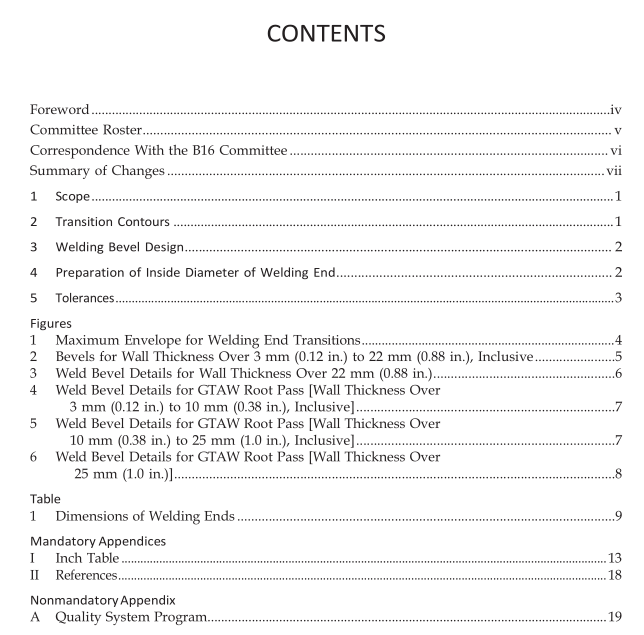ASME B16.25 pdf download

ASME B16.25 pdf download Buttwelding Ends
1.5 Referenced Standards Standards and specifications adopted by reference in this Standard are shown in Mandatory Appendix II. It is not considered practical to identify the specific edition of each standard and specification in the individual ref- erences. Instead, the specific edition reference is identi- fied in Mandatory Appendix II. A product made in conformance with a prior edition of referenced stan- dards will be considered to be in conformance, even though the edition reference may be changed in a subse- quent revision of the standard.
1.6 Quality Systems Nonmandatory requirements relating to the manufac- turer ’s quality system program are described in Nonmandatory Appendix A.
1.7 Convention For determining conformance with this Standard, the convention for fixing significant digits where limits (maximum and minimum values) are specified shall be as defined in ASTM E29. This requires that an observed or calculated value be rounded off to the nearest unit in the last right-hand digit used for expressing the limit. Decimal values and tolerances do not imply a particular method of measurement.
2 TRANSITION CONTOURS Figure 1 delineates the maximum envelope in which transitions from welding bevel to the outer surface of the component and from the root face to the inner surface of the component must lie. Except as specified in Note (5) to Fig. 1, and as otherwise specified by the purchaser, the exact contour within this envelope is the manufacturer’s option, provided it maintains the specified minimum wall thickness, has no slopes steeper than those indi- cated for the respective regions, and includes the proper surface for backing rings if specified.
3 WELDING BEVEL DESIGN
3.1 Bevels for Other Than GTAW Root Pass
(a) Components having nominal wall thicknesses of 3 mm (0.12 in.) and less shall have ends cut square or slightly chamfered.
(b) Components having nominal wall thicknesses over 3 mm (0.12 in.) to 22 mm (0.88 in.) inclusive shall have single angle bevels as illustrated in Fig. 2.
(c) Components having nominal wall thicknesses greater than 22 mm (0.88 in.) shall have compound angle bevels as illustrated in Fig. 3. 3.2 Bevels for GTAW Root Pass (a) Components having nominal wall thicknesses of 3 mm (0.12 in.) and less shall have ends cut square or slightly chamfered. (b) Components having nominal wall thicknesses over 3 mm (0.12 in.) to 10 mm (0.38 in.) inclusive shall have 37 1 ⁄ 2 -deg ± 2 1 ⁄ 2 -deg bevels or slightly concave bevels (see Fig. 4). (c) Components having nominal wall thicknesses over 10 mm (0.38 in.) to 25 mm (1.0 in.) inclusive shall have bevels as shown in Fig. 5.
(d) Components having nominal wall thicknesses greater than 25 mm (1.0 in.) shall have bevels as shown in Fig. 6. 3.3 Outside Diameter at Welding Ends Dimension A shall be either that specified in the applicable component standard or that specified in the purchaser’s component specification. In the absence of a requirement for dimension A in a component stan- dard or a purchaser’s specification, the values for dimen- sion A in Table 1 or Table I-1 may be used.
4 PREPARATION OF INSIDE DIAMETER OF WELDING END
4.1 General Preparation of the inside diameter at the end of a component shall be in accordance with one of the following, as specified by the purchaser:
(a) Components to be welded without backing rings shall meet the requirements of the standard or specifica- tion for the component.
(b) Components to be welded using split or noncon- tinuous backing rings shall be contoured with a cylindri- cal surface at the end as shown in Fig. 2, illustration (b) and Fig. 3, illustration (b). If the backing ring contour is other than rectangular, details must be furnished by the purchaser.
(c) Components to be welded using solid or continu- ous backing rings shall be contoured with a cylindrical or tapered surface at the end as specified by the pur- chaser. End preparation is illustrated in Fig. 2, illustra- tion (c) and Fig. 3, illustration (c) for rectangular ends and in Fig. 2, illustration (d) and Fig. 3, illustration (d) for tapered ends.









